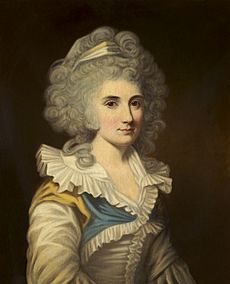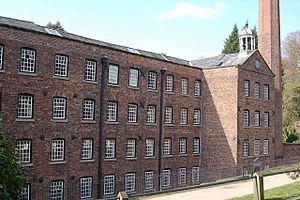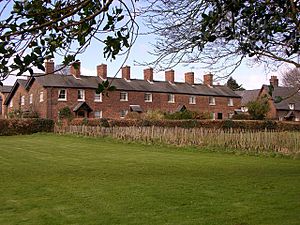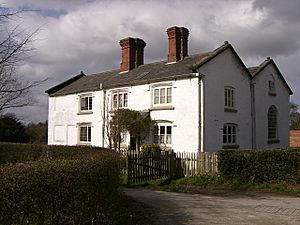Samuel Greg facts for kids
Quick facts for kids
Samuel Greg
|
|
|---|---|
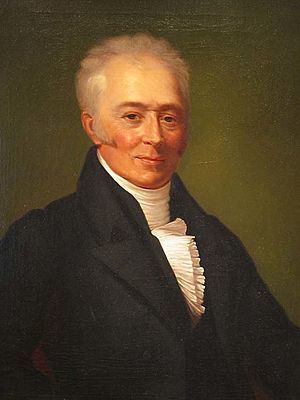
Samuel Greg circa 1820
|
|
| Born | 26 March 1758 |
| Died | 4 June 1834 (aged 76) Styal, Cheshire
|
| Alma mater | Harrow School |
| Occupation |
|
| Known for | Quarry Bank Mill, Styal, Cheshire |
| Spouse(s) | Hannah Lightbody |
| Children |
|
Samuel Greg (born March 26, 1758 – died June 4, 1834) was an important businessman and factory owner from Ireland. He lived during the early Industrial Revolution. He was a pioneer of the factory system, which meant he helped create the modern way factories work.
Samuel Greg built Quarry Bank Mill. When he retired, it was the biggest textile factory in the country. He and his wife, Hannah Greg, cared for their workers. Many of these workers were children. They even built a special village next to the factory for them. However, Samuel Greg also owned and ran a plantation in the Caribbean that used enslaved people.
Contents
Early Life and Family Business
Samuel Greg was born in Belfast, Ireland. He was one of thirteen children. His father, Thomas Greg, was a very rich merchant in Ireland. Thomas Greg and his business partner, Waddell Cunningham, had one of the biggest trading companies in Ireland.
Thomas Greg started his business by buying a small ship. This ship carried food and linen to the Caribbean. It brought back flaxseed, which is used to make linen. His company, Greg and Cunningham, grew very large. They also had a sugar plantation on the island of Dominica. This plantation used enslaved people.
When Samuel was eight years old, he moved to Manchester, England. He lived with his uncle, Robert Hyde, who was a linen merchant. After finishing school at Harrow School, Samuel joined his uncles' business in 1778.
Marriage and Hannah's Influence
In 1789, Samuel Greg married Hannah Lightbody. Hannah's father was a rich merchant from Liverpool. Hannah was a Unitarian, a type of Christian faith that encouraged people to think for themselves.
Hannah's beliefs greatly influenced Samuel. She believed in treating people well and taking responsibility for others. This influenced how Samuel treated the workers at his factory.
Building Quarry Bank Mill
In 1782, Samuel Greg took over his uncle's business interests. He believed that new machines and water and steam power would change textile making. He used his wife's dowry (money she brought into the marriage) to build Quarry Bank Mill. The mill was in Styal, Cheshire, by the River Bollin.
It was hard to find workers in the countryside. Hannah Greg's ideas led Samuel to invest in better conditions for his workers. This made the factory work more appealing. In Styal, Greg created what was called a "model village." Each family had a cottage with a living room, kitchen, two bedrooms, and a garden.
By 1790, half of the mill's workers were children. Factory owners were paid for each child they employed from workhouses. The children lived in a special building called the Apprentice House. They received food, lodging, and a small amount of money each week. Younger children did simple jobs like cleaning. Older children learned spinning and carding. Some boys even became skilled mechanics.
Hannah Greg looked after the children. She arranged for a doctor, two teachers, and two singing teachers. After their thirteen-hour workday, Hannah taught them reading, writing, and math. She also preached to the girls on Sundays. Her own thirteen children were expected to help with the teaching.
By 1816, Quarry Bank Mill had 252 workers. It produced a lot of cotton cloth. Ten years later, it had 380 workers and made even more cloth. Samuel Greg sold cloth in Britain and to countries like Italy, France, and America.
His success led him to open more mills. By 1831, Samuel Greg & Company owned five factories. They had over 4,000 power looms and employed more than 2,000 people. They produced a large amount of Britain's cotton cloth.
Slave Ownership
The good conditions at Styal were not the same for all of Greg's businesses. In 1795, Samuel Greg and his brother Thomas inherited the Hillsborough Estate. This was a slave plantation on the island of Dominica. They continued to operate it using enslaved people. The enslaved Africans on the estate received clothing and blankets made at Quarry Bank Mill.
In 2020, the National Trust, which now owns Quarry Bank Mill, stated that the mill was built using family wealth connected to slavery. Samuel Greg, his father, and his uncle had interests in several estates in the Caribbean that used enslaved labor. The National Trust is working to include information about these links to slavery in their displays at the mill.
Later Life and Legacy
In 1832, Samuel Greg was injured by a stag at Quarry Bank Mill. This injury led him to retire. By then, his business was the largest spinning and weaving company in the United Kingdom. He died two years later.
Samuel and Hannah had thirteen children. Some of them continued their parents' work in different ways:
- Robert Hyde Greg continued in the textile business.
- Samuel Rathbone Greg became a writer. He argued that cotton and sugar could be grown more cheaply without using enslaved labor.
- Elizabeth Greg founded the first public wash-houses in the United Kingdom. She also helped create the Education Act 1870, which made education more widely available.
The Quarry Bank Mill and estate were later given to the National Trust in 1939.


